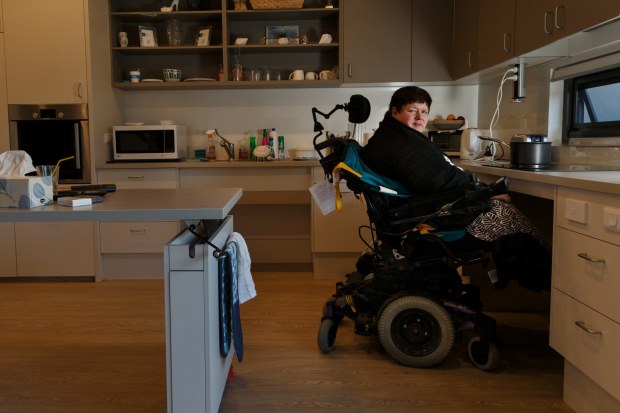Land costs distort disability housing provision, developers say

Fast-rising housing prices will worsen an existing imbalance in the provision of Specialist Disability Accommodation that has already created a shortage of larger houses for clients with behavioural problems stemming from conditions such as high-end autism, developers say.
Developers and investors are increasingly showing interest in specialist accommodation funded by National Disability Insurance Scheme payments, an asset class forecast by some to grow into a $5 billion sector housing some 28,000 people.

Specialist housing for clients in electric wheelchairs such as Kim Macintosh in Newcastle can be built densely and require less land than accommodation for people with other categories of disability. Max Mason-Hubers
However, SDA payments funding the accommodation do not account for the greater land needs of some housing types, and the inflation-linked increases in payments are widening the gap in a housing market that even after five months of falling prices last year made affordable land scarce, according to Charles Northcote, the chief executive of developer BlueCHP.
“If you’re looking to build three- to four-bedroom homes, that’s even scarcer still,” Mr Northcote told The Australian Financial Review.
“We compete with developers who could put a duplex on the same block. You’ve got a different market dynamic you’re competing against.”
The SDA sector and funding stream was developed to provide housing for people with special housing needs – mostly young – who without a purpose-built alternative, would often end up in aged-care facilities, as these were the only institutions able to care for them adequately.
A new report by the not-for-profit Summer Foundation shows, however, that while the scheme envisages a range of different housing categories for people with different needs, the market is overwhelmingly producing housing types that can be developed with less land and not enough of homes that require more.
For example, so-called high physical support homes, usually for clients in electric wheelchairs who also require hoists to get in and out of bed, can be built densely as apartments. By contrast, so-called robust homes have to be built as single dwellings on larger blocks to accommodate tenants with behavioural problems and create enough space around them.
The foundation's survey of providers in October and November found that two-thirds – 1139 – of the 1800 new SDA places in development were high physical support, while only 113 places, or 6.6 per cent, were in the robust category. The imbalance has persisted over several years.
“It is likely that supply of high physical support dwellings is outstripping the number of people with this level of SDA in their plans at this time,” the report said.
Others say the imbalance isn't just about real estate.
Summer Foundation chief executive Di Winkler said developers were likely less confident about robust housing because the dwellings were specially designed and didn't have a clear alternate use, “If you end up with vacancy and you can’t easily lease or sell that on the open market.”
Robust housing clients needed space for various reasons, Mr Northcote said.
“Autism is the big one, that high-end autism,” he said. “They need space. Triggers like noise, or people coming on the property – all these things can be triggers and you need to provide them with a safe house that manages their behaviours.”
But that space was expensive to buy and even while dwelling values fell on average for much of the year, in many of the areas people wanted to live – to be close to their family and community – prices hadn't fallen at all, he said.
“In [northern Sydney suburb] Lane Cove, we were looking to buy a block of land suitable for three robust clients,” Mr Northcote said. “We went to go to auction to buy the land. It had an indicative price above $1.8 million and it went for $2.3 million. At $2.3 million we’re not even close [financially].”
Subscribe to gift this article
Gift 5 articles to anyone you choose each month when you subscribe.
Subscribe nowAlready a subscriber?
Introducing your Newsfeed
Follow the topics, people and companies that matter to you.
Find out moreRead More
Latest In Commercial
Fetching latest articles